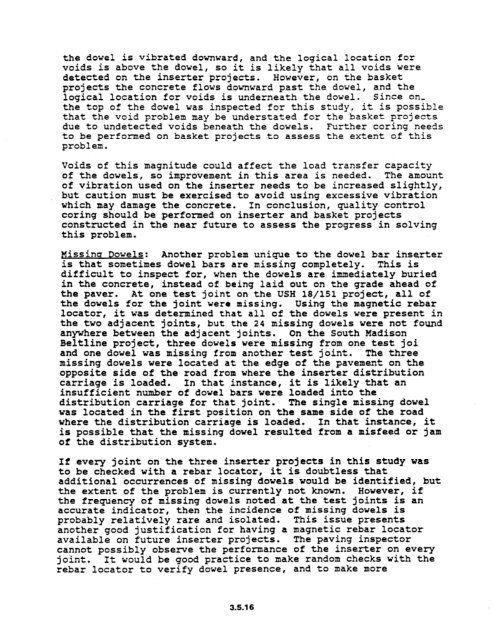chapter 3 rigid pavement - DOT On-Line Publications - Department ...
chapter 3 rigid pavement - DOT On-Line Publications - Department ...
chapter 3 rigid pavement - DOT On-Line Publications - Department ...
Create successful ePaper yourself
Turn your PDF publications into a flip-book with our unique Google optimized e-Paper software.
the dowel is vibrated downward, and the logical location for<br />
voids is above the dowel, so it is likely that all voids were<br />
detected on the inserter projects. However, on the basket<br />
projects the concrete flows downward past the dowel, and the<br />
logical location for voids is underneath the dowel. Since on,,<br />
the top of the dowel was inspected for this study, it is possible<br />
that the void problem may be understated for the basket projects<br />
due to undetected voids beneath the dowels. Further coring needs<br />
to be performed on basket projects to assess the extent of this<br />
problem.<br />
Voids of this magnitude could affect the load transfer capacity<br />
of the dowels, so improvement in this area is needed. The amount<br />
of vibration used on the inserter needs to be increased slightly,<br />
but caution must be exercised to avoid using excessive vibration<br />
which may damage the concrete. In conclusion, quality control<br />
coring should be performed on inserter and basket projects<br />
constructed in the near future to assess the progress in solving<br />
this problem.<br />
plissina Dowels: Another problem unique to the dowel bar inserter<br />
is that sometimes dowel bars are missing completely. This is<br />
difficult to inspect for, when the dowels are immediately buried<br />
in the concrete, instead of being laid out on the grade ahead of<br />
the paver. At one test joint on the USH 18/151 project, all of<br />
the dowels for the joint were missing. Using the xnagnetic rebar<br />
locator, it was determined that all of the dowels were present in<br />
the two adjacent joints, but the 24 missing dowels were not found<br />
anywhere between the adjacent joints. <strong>On</strong> the South Madison<br />
Beltline project, three dowels were missing from one test joi<br />
and one dowel was missing from another test joint. The three<br />
missing dowels were located at the edge of the <strong>pavement</strong> on the<br />
opposite side of the road from where the inserter distribution<br />
carriage is loaded. In that instance, it is likely that an<br />
insufficient number of dowel bars were loaded into the<br />
distribution carriage for that joint. The single missing dowel<br />
was located in the first position on the same side of the road<br />
where the distribution carriage is loaded. In that instance, it<br />
is possible that the missing dowel resulted from a misfeed or jam<br />
of the distribution system.<br />
If every joint on the three inserter projects in this study was<br />
to be checked with a rebar locator, it is doubtless that<br />
additional occurrences of missing dowels would be identified, but<br />
the extent of the problem is currently not known. However, if<br />
the frequency of missing dowels noted at the test joints is an<br />
accurate indicator, then the incidence of missing dowels is<br />
probably relatively rare and isolated. This issue presents<br />
another good justification for having a magnetic rebar locator<br />
available on future inserter projects. The paving inspector<br />
cannot possibly observe the performance of the inserter on every<br />
joint. It would be good practice to make random checks with the<br />
rebar locator to verify dowel presence, and to make more<br />
3.5.16
















